Thermodynamic Constraints on REE Mineral Paragenesis in the Bayan Obo REE-Nb-Fe Deposit, China
Abstract
1. Introduction
2. Geological Setting
3. Methods
4. Petrographic Conditions of REE and Gangue Minerals Related to Thermodynamic Calculation
5. Results
5.1. LREE Fractionation during Precipitation of Monazite
5.2. Replacement of Bastnaesite by Monazite
5.3. Replacement of Parisite by Bastnaesite
6. Discussion
6.1. REE Fractionation Indicated by Monazite Precipitation
6.2. Replacement of Bastnaesite by Monazite
6.3. Replacement of Parisite by Bastnaesite
7. Conclusions
Supplementary Materials
Author Contributions
Funding
Acknowledgments
Conflicts of Interest
References
- Zhu, X.K.; Sun, J.; Pan, C.X. Sm–Nd isotopic constraints on rare-earth mineralization in the Bayan Obo ore deposit, Inner Mongolia, China. Ore Geol. Rev. 2015, 64, 543–553. [Google Scholar] [CrossRef]
- Fan, H.R.; Yang, K.F.; Hu, F.F.; Liu, S.; Wang, K.Y. The giant Bayan Obo REE-Nb-Fe deposit, China: Controversy and ore genesis. Geosci. Front. 2016, 7, 335–344. [Google Scholar]
- Yang, X.Y.; Lai, X.D.; Pirajno, F.; Liu, Y.L.; Ling, M.X.; Sun, W.D. The Bayan Obo (China) giant REE accumulation conundrum elucidated by intense magmatic differentiation of carbonatite. Precambrian Res. 2017, 288, 39–71. [Google Scholar] [CrossRef]
- Yang, K.F.; Fan, H.R.; Pirajno, F.; Li, X.C. The Bayan Obo (China) giant REE accumulation conundrum elucidated by intense magmatic differentiation of carbonatite. Geology 2019, 47, 1198–1202. [Google Scholar]
- Smith, M.P.; Henderson, P. Preliminary Fluid Inclusion Constraints on Fluid Evolution in the Bayan Obo Fe-REE-Nb Deposit, Inner Mongolia, China. Econ. Geol. 2000, 95, 1371–1388. [Google Scholar] [CrossRef]
- Chen, W.; Liu, Y.L.; Lu, J.; Jiang, S.Y.; Simonetti, A.; Xu, C.; Zhang, W. The formation of the ore-bearing dolomite marble from the giant Bayan Obo REE-Nb-Fe deposit, Inner Mongolia: Insights from micron-scale geochemical data. Miner. Deposita 2020, 55, 131–146. [Google Scholar]
- Liu, S.; Fan, H.R.; Groves, D.I.; Yang, K.F.; Yang, Z.F.; Wang, Q.W. Multiphase carbonatite-related magmatic and metasomatic processes in the genesis of the ore-hosting dolomite in the giant Bayan Obo REE-Nb-Fe deposit. Lithos 2020, 354–355, 105359. [Google Scholar] [CrossRef]
- Fan, H.R.; Xie, Y.H.; Wang, K.Y.; Tao, K.J. REE Daughter Minerals Trapped in Fluid Inclusions in the Giant Bayan Obo REE-Nb-Fe Deposit, Inner Mongolia, China. Int. Geol. Rev. 2004, 46, 638–645. [Google Scholar]
- Qin, C.J.; Qiu, Y.Z.; Zhou, G.F.; Wang, Z.G.; Zhang, T.R.; Xiao, G.R. Fluid inclusion study of carbonatite dykes/veins and ore-hosted dolostone at the Bayan Obo deposit. Acta Petrol. Sin. 2007, 23, 161–168. [Google Scholar]
- Wang, K.Y.; Fan, H.R.; Yang, K.F.; Hu, F.F.; Wu, C.M.; Hu, F.Y. Calcite-dolomite geothermometry of Bayan Obo carbonatites. Acta Petrol. Sin. 2010, 26, 1141–1149, (In Chinese with English abstract). [Google Scholar]
- Migdisov, A.A.; Williams-Jones, A.E.; Wagner, T. An experimental study of the solubility and speciation of the Rare Earth Elements (III) in fluoride- and chloride-bearing aqueous solutions at temperatures up to 300 °C. Geochim. Cosmochim. Acta 2009, 73, 7087–7109. [Google Scholar]
- Gysi, A.P.; Williams-Jones, A.E. The thermodynamic properties of bastnäsite-(Ce) and parisite-(Ce). Chem. Geol. 2015, 392, 87–101. [Google Scholar] [CrossRef]
- Williams-Jones, A.E.; Migdisov, A.A.; Samson, I.M. Hydrothermal mobilization of the rare earth elements-a tale of “Ceria” and “Yttria”. Elements 2012, 8, 355–360. [Google Scholar] [CrossRef]
- Migdisov, A.A.; Williams-Jones, A.E. Hydrothermal transport and deposition of the rare earth elements by fluorine-bearing aqueous liquids. Mineral. Deposita 2014, 49, 987–997. [Google Scholar] [CrossRef]
- Migdisov, A.A.; Williams-Jones, A.E.; Brugger, J.; Caporiscio, F.A. Hydrothermal transport, deposition, and fractionation of the REE: Experimental data and thermodynamic calculations. Chem. Geol. 2016, 439, 13–42. [Google Scholar]
- Drew, L.J.; Meng, Q.R.; Sun, W.J. The Bayan Obo iron-rare-earth-niobium deposits, Inner Mongolia, China. Lithos 1990, 26, 43–65. [Google Scholar] [CrossRef]
- Chao, E.C.T.; Back, J.M.; Minkin, J.A. Host-rock controlled epigenetic, hydrothermal metasomatic origin of the Bayan Obo REE-Fe-Nb ore deposit, Inner Mongolia, P.R.C. Appl. Geochem. 1992, 7, 443–458. [Google Scholar] [CrossRef]
- Yang, K.F.; Fan, H.R.; Santosh, M.; Hu, F.F.; Wang, K.Y. Mesoproterozoic mafic and carbonatitic dykes from the northern margin of the North China Craton: Implications for the final breakup of Columbia supercontinent. Tectonophysics 2011, 498, 1–10. [Google Scholar]
- Wang, K.Y.; Fan, H.R.; Xie, Y.H.; Li, H.M. The zircon U-Pb dating of basement complex of the giant Bayan Obo REE-Fe-Nb deposit. Chin. Sci. B 2001, 46, 1390–1394. (In Chinese) [Google Scholar]
- Fan, H.R.; Yang, K.F.; Hu, F.F.; Wang, K.Y.; Zhai, M.G. Zircon geochronology of basement rocks from the Bayan Obo area, Inner Mongolia, and tectonic implications. Acta Petrol. Sin. 2010, 26, 1342–1350, (In Chinese with English abstract). [Google Scholar]
- Liu, J.; Li, Y.; Ling, M.X.; Sun, W.D. Chronology and geological significance of the basement rock of the giant Bayan Obo REE-Nb-Fe ore deposit. Geochimica 2011, 40, 209–222, (In Chinese with English abstract). [Google Scholar]
- Zhong, Y.; Zhai, M.G.; Peng, P.; Santosh, M.; Ma, X.D. Detrital zircon U–Pb dating and whole-rock geochemistry from the clastic rocks in the northern marginal basin of the North China Craton: Constraints on depositional age and provenance of the Bayan Obo Group. Precambrian Res. 2015, 258, 133–145. [Google Scholar] [CrossRef]
- Liu, Y.F.; Bagas, L.; Nie, F.J.; Jiang, S.H.; Li, C. Re–Os system of black schist from the Mesoproterozoic Bayan Obo Group, Central Inner Mongolia, China and its geological implications. Lithos 2016, 261, 296–306. [Google Scholar] [CrossRef]
- Liu, C.H.; Zhao, G.C.; Liu, F.L.; Shi, J.R. Detrital zircon U-Pb and Hf isotopic and whole-rock geochemical study of the Bayan Obo Group, northern margin of the North China Craton: Implications for Rodinia reconstruction. Precambrian Res. 2017, 303, 372–391. [Google Scholar] [CrossRef]
- Zhou, Z.G.; Hu, M.M.; Wu, C.; Wang, G.S.; Liu, C.F.; Cai, A.R.; Jiang, T. Coupled U–Pb dating and Hf isotopic analysis of detrital zircons from Bayan Obo Group in Inner Mongolia: Constraints on the evolution of the Bayan Obo rift belt. Geol. J. 2017, 53, 1–16. [Google Scholar] [CrossRef]
- Le Bas, M.J.; Keller, J.; Tao, K.J.; Wall, F.; Williams, C.T.; Zhang, P.S. Carbonatite dykes at Bayan Obo, Inner Mongolia, China. Mineral. Petrol. 1992, 46, 195–228. [Google Scholar] [CrossRef]
- Xiao, R.G.; Fei, H.C.; Wang, A.J.; Yang, F.; Yan, K. Formation and geochemistry of the ore-bearing alkaline volcanic rocks in the Bayan Obo REE-Nb-Fe deposit, Inner Mongolia, China. Acta Geol. Sin. 2012, 86, 735–751, (In Chinese with English abstract). [Google Scholar]
- Wang, K.Y.; Fang, A.M.; Zhang, J.E.; Yu, L.J.; Dong, C.; Zan, J.F.; Hao, M.Z. Genetic relationship between fenitized ores and hosting dolomite carbonatite of the Bayan Obo REE deposit, Inner Mongolia, China. J. Asian Earth Sci. 2019, 174, 189–204. [Google Scholar] [CrossRef]
- Yang, X.M.; Yang, X.Y.; Chen, T.H.; Zhang, P.S.; Le Bas, M.J.; Henderson, P. Geochemical constraints on the genesis of the Bayan Obo Fe-Nb-REE deposit in Inner Mongolia, China. J. Chin. Rare Earths Soc. 1999, 17, 289–295, (In Chinese with English abstract). [Google Scholar] [CrossRef]
- Wagner, T.; Kulik, D.A.; Hingerl, F.F.; Dmytrieva, S.V. GEM-Selektor geochemical modeling package: TSolMod library and data interface for multicomponent phase models. Can. Mineral. 2012, 50, 1173–1195. [Google Scholar] [CrossRef]
- Kulik, D.A.; Wagner, T.; Dmytrieva, S.V.; Kosakowski, G.; Hingerl, F.F.; Chudnenko, K.V.; Berner, U. GEM-Selektor geochemical modeling package: Revised algorithm and GEMS3K numerical kernel for coupled simulation codes. Comput. Geosci. 2013, 17, 1–24. [Google Scholar] [CrossRef]
- Thoenen, T.; Hummel, W.; Berner, U.; Curti, E. The PSI/Nagra Chemical Thermodynamic Database 12/07; Paul Scherrer Institut, Villigen PSI: Villigen, Switzerland, 2014; pp. 1–445. [Google Scholar]
- Gysi, A.P.; Williams-Jones, A.E. Hydrothermal mobilization of pegmatite-hosted Zr and REE at Strange Lake, Canada: A reaction path model. Geochim. Cosmochim. Acta 2013, 122, 324–352. [Google Scholar] [CrossRef]
- Gysi, A.P. Numerical simulations of CO2 sequestration in basaltic rock formations: Challenges for optimizing mineral-fluid reactions. Pure Appl. Chem. 2017, 89, 581–596. [Google Scholar] [CrossRef]
- Konings, R.J.M.; Kovács, A. Thermodynamic properties of the lanthanide (III) halides. Handb. Phys. Chem. Rare Earths 2003, 33, 147–247. [Google Scholar]
- Ni, Y.X.; Hughes, M.; Mariano, A.N. Crystal chemistry of the monazite and xenotime. Am. Mineral. 1995, 80, 21–26. [Google Scholar] [CrossRef]
- Ushakov, S.V.; Helean, K.B.; Navrotsky, A.; Boatner, L.A. Thermochemistry of rare-earth orthophosphates. J. Mater. Res. 2001, 16, 2623–2633. [Google Scholar] [CrossRef]
- Thiriet, C.; Konings, R.J.M.; Jovorský, P.; Magnani, N.; Wastin, F. The low temperature heat capacity of LaPO4 and GdPO4, the thermodynamic functions of the monazite-type LnPO4 series. J. Chem. Thermodyn. 2005, 37, 131–139. [Google Scholar] [CrossRef]
- Popa, K.; Sedmidubský, D.; Beneš, O.; Thiriet, C.; Konings, R.J.M. The high-temperature heat capacity of LnPO4 (Ln = La, Ce, Gd) by drop calorimetry. J. Chem. Thermodyn. 2006, 38, 825–829. [Google Scholar] [CrossRef]
- Popa, K.; Jutier, F.; Wastin, F.; Konings, R.J.M. The heat capacity of NdPO4. J. Chem. Thermodyn. 2006, 38, 1306–1311. [Google Scholar] [CrossRef]
- Popa, K.; Konings, R.J.M. High-temperature heat capacities of EuPO4 and SmPO4 synthetic monazites. Thermochim. Acta 2006, 445, 49–52. [Google Scholar] [CrossRef]
- Jemal, M. Thermochemistry and relative stability of apatite phosphates. Phosphorus Res. B 2004, 15, 119–124. [Google Scholar]
- Cruz, F.J.A.L.; Minas da Piedade, M.E.; Calado, J.C.G. Standard molar enthalpies of formation of hydroxy-, chlor-, and bromapatite. J. Chem. Thermodyn. 2005, 37, 1061–1070. [Google Scholar]
- Cruz, F.J.A.L.; Canongia Lopes, J.N.; Calado, J.C.G.; Minas da Piedade, M.E. A Molecular Dynamics Study of the Thermodynamic Properties of Calcium Apatites. 1. Hexagonal Phases. J. Phys. Chem. B 2005, 109, 24473–24479. [Google Scholar] [CrossRef] [PubMed]
- Dachs, E.; Harlov, D.; Benisek, A. Excess heat capacity and entropy of mixing along the chlorapatite–fluorapatite binary join. Phys. Chem. Miner. 2010, 37, 665–676. [Google Scholar] [CrossRef]
- Bühn, B.; Rankin, A.H. Composition of natural, volatile-rich Na-Ca-REE-Sr carbonatitic fluids trapper in fluid inclusions. Geochim. Cosmochim. Acta 1999, 63, 3781–3797. [Google Scholar] [CrossRef]
- Banks, D.A.; Yardley, B.W.D.; Campbell, A.R.; Jarvis, K.E. REE composition of an aqueous magmatic fluid: A fluid inclusion study from the Capitan Pluton, New Mexico, U.S.A. Chem. Geol. 1994, 113, 259–272. [Google Scholar] [CrossRef]
- Liu, S.; Fan, H.R.; Yang, K.F.; Hu, F.F.; Rush, B.; Liu, X.; Li, X.C.; Yang, Z.F.; Wang, Q.W.; Wang, K.Y. Fenitization in the Giant Bayan Obo REE-Nb-Fe Deposit: Implication for REE Mineralization. Ore Geol. Rev. 2018, 94, 290–309. [Google Scholar] [CrossRef]
- Krneta, S.; Ciobanu, C.L.; Cook, N.J.; Ehrig, K.J. Numerical Modeling of REE Fractionation Patterns in Fluorapatite from the Olympic Dam Deposit (South Australia). Minerals 2018, 8, 342. [Google Scholar] [CrossRef]
- Smith, M.P.; Henderson, P.; Zhang, P.S. Reaction relationships in the Bayan Obo Fe-REE-Nb deposit Inner Mongolia, China: Implications for the relative stability of rare-earth element phosphates and fluorocarbonates. Contrib. Mineral. Petrol. 1999, 134, 294–310. [Google Scholar]
- Liu, Y.L.; Chen, J.F.; Li, H.M.; Qian, H.; Xiao, G.W.; Zhang, T.R. Single-grain U-Th-Pb-Sm-Nd dating of monazite from dolomite type ore of the Bayan Obo deposit. Acta Petrol. Sin. 2005, 21, 881–888, (In Chinese with English abstract). [Google Scholar]
- Liu, S.; Fan, H.R.; Yang, K.F.; Hu, F.F.; Wang, K.Y.; Chen, F.K.; Yang, Y.H.; Yang, Z.F.; Wang, Q.W. Mesoproterozoic and Paleozoic hydrothermal metasomatism in the giant Bayan Obo REE-Nb-Fe deposit: Constrains from trace elements and Sr-Nd isotope of fluorite and preliminary thermodynamic calculation. Precambrian Res. 2018, 311, 228–246. [Google Scholar] [CrossRef]
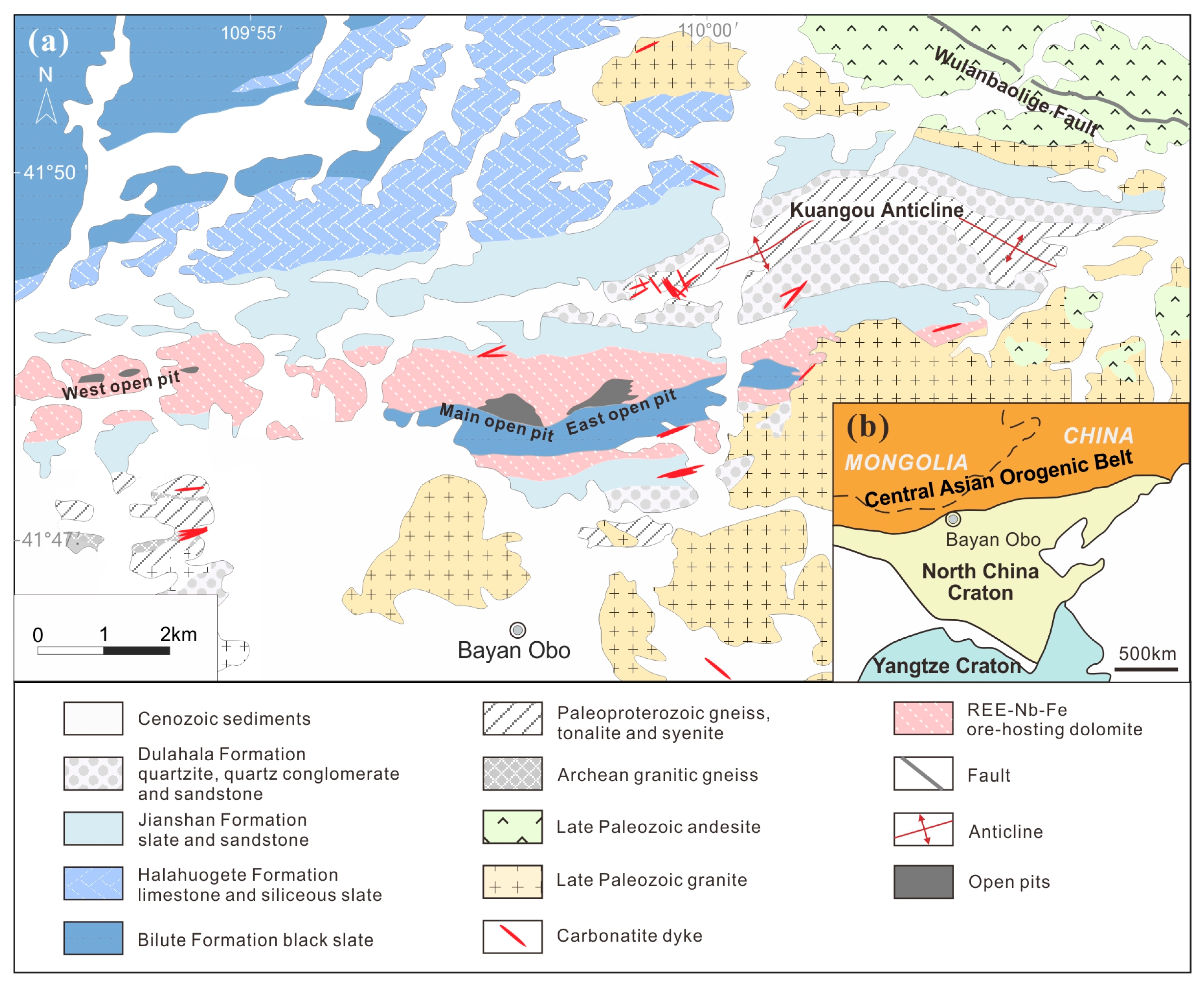
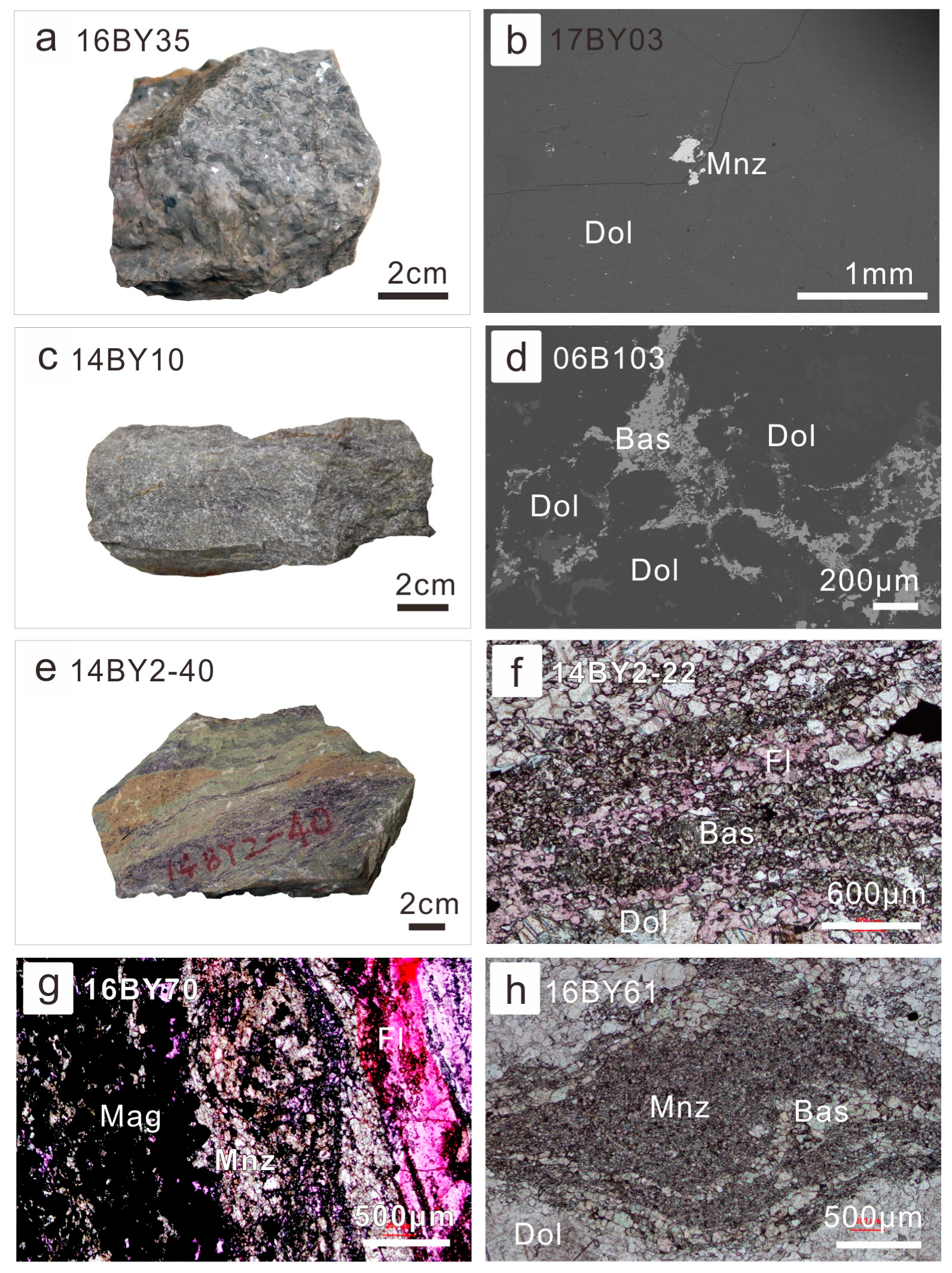

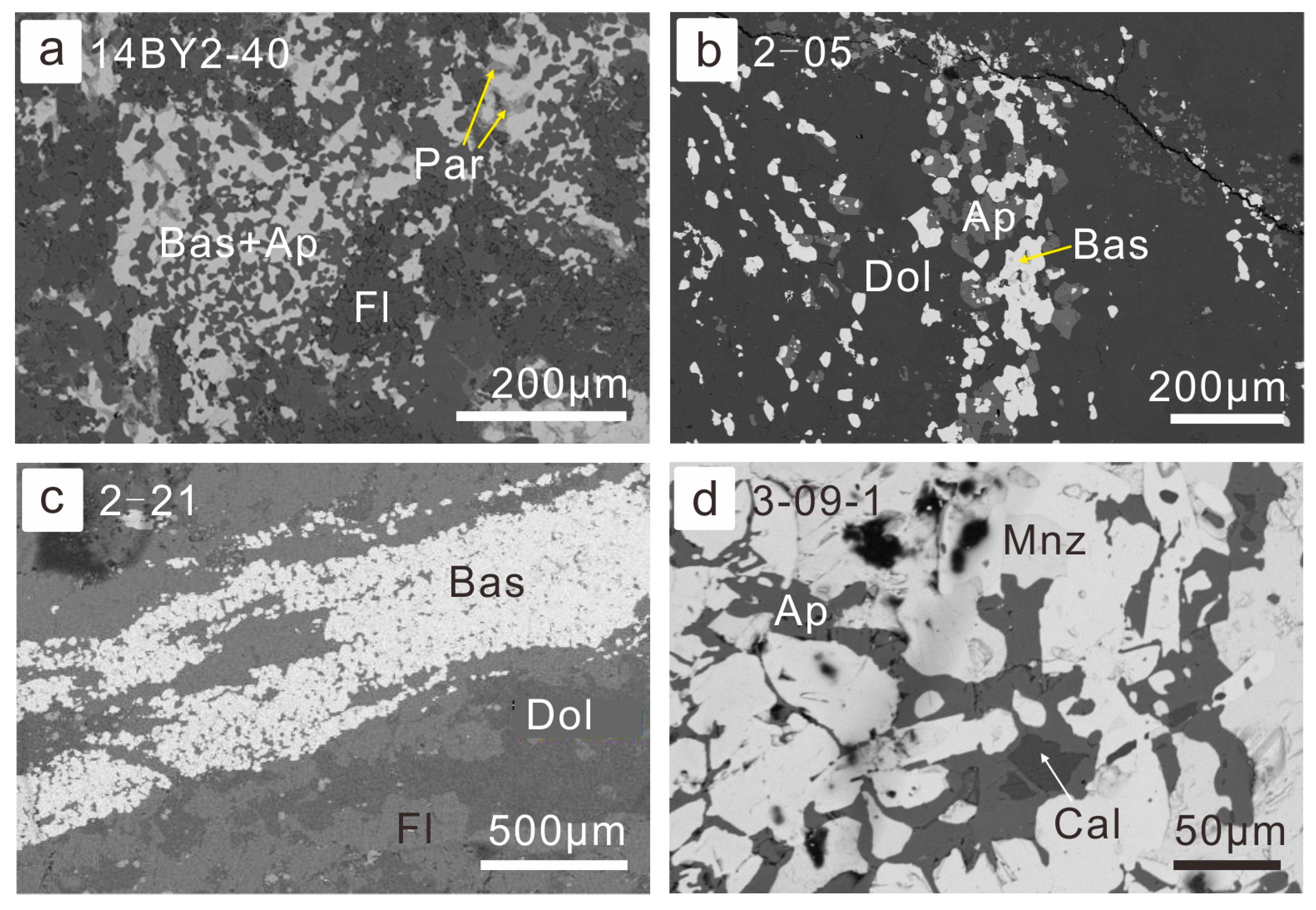

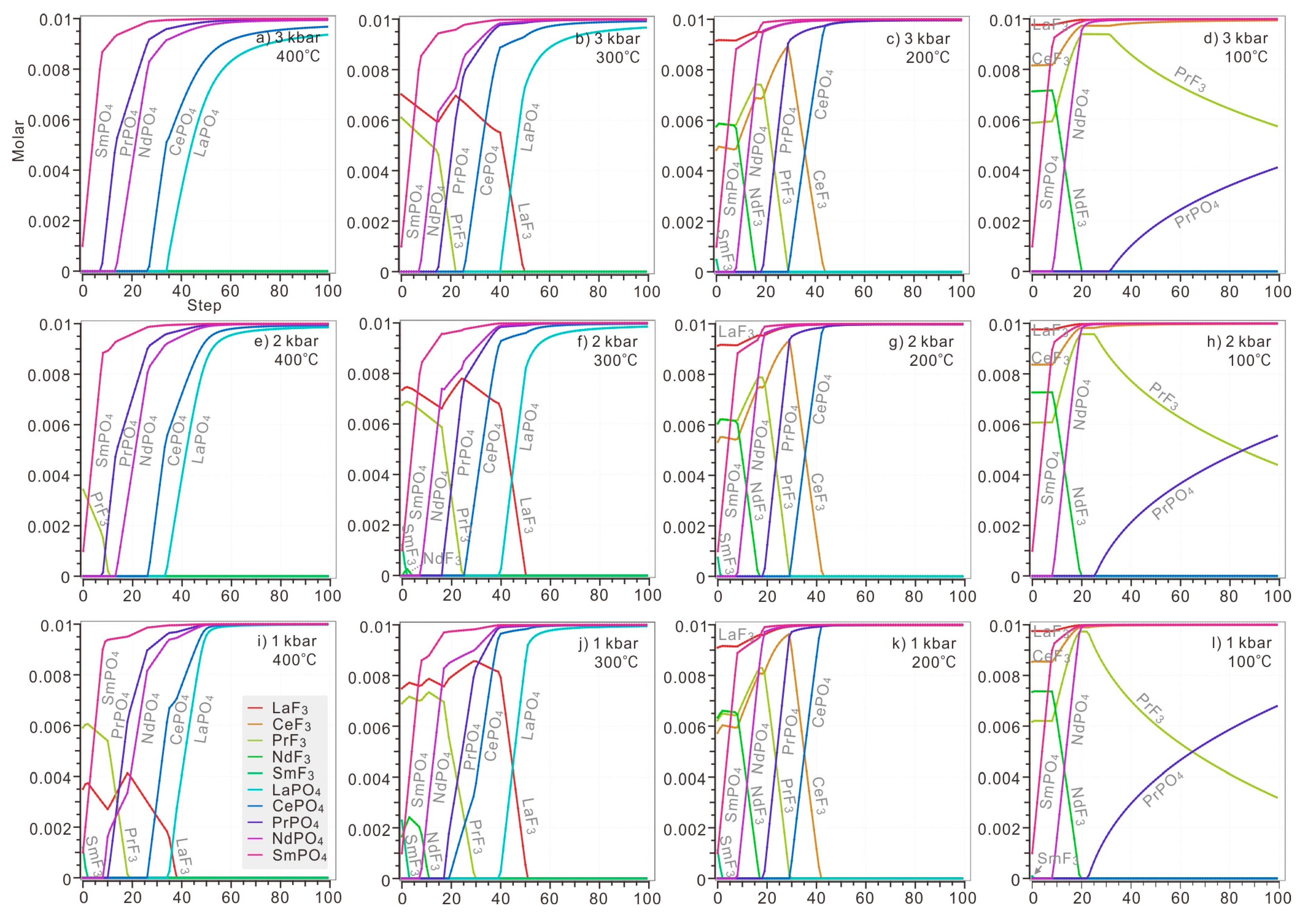
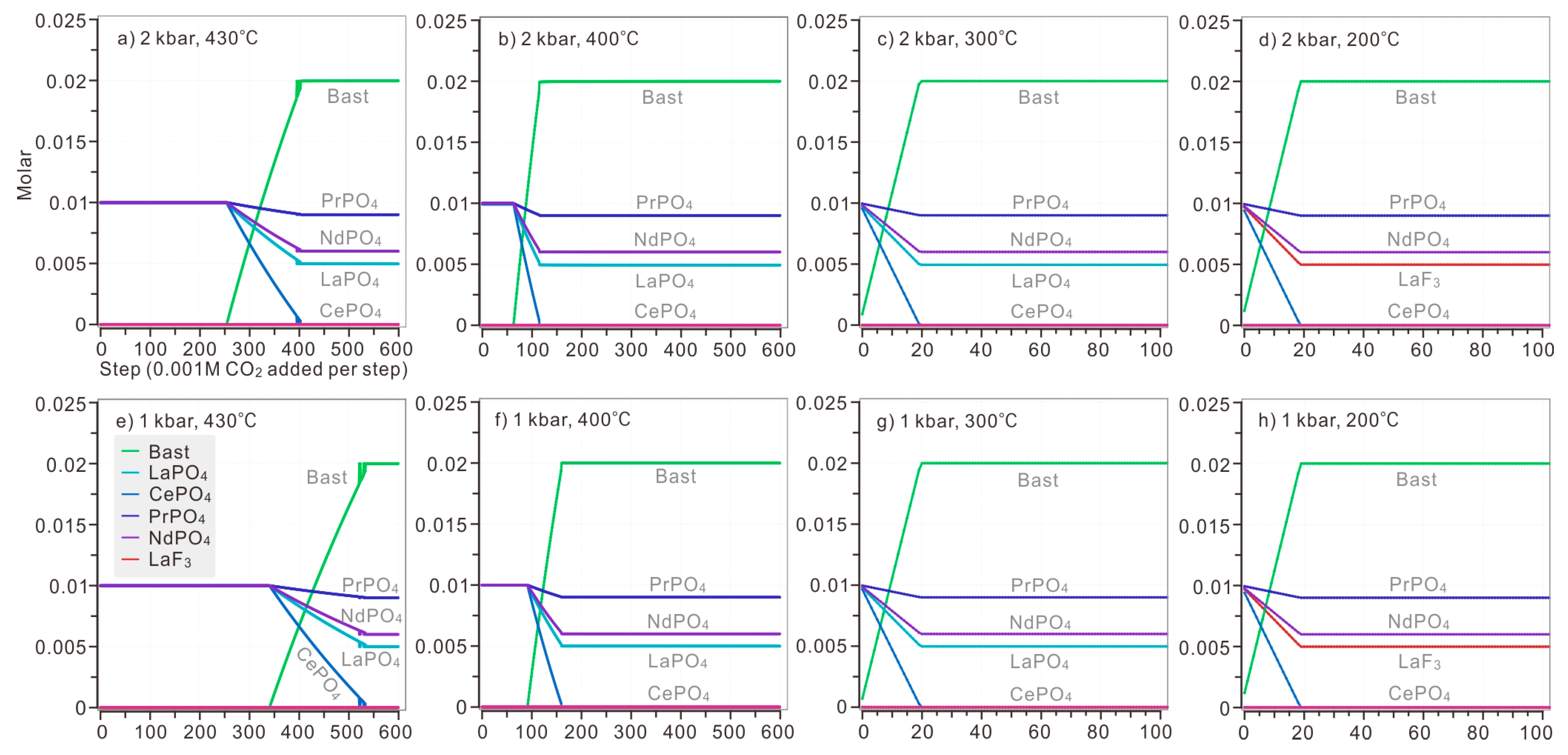
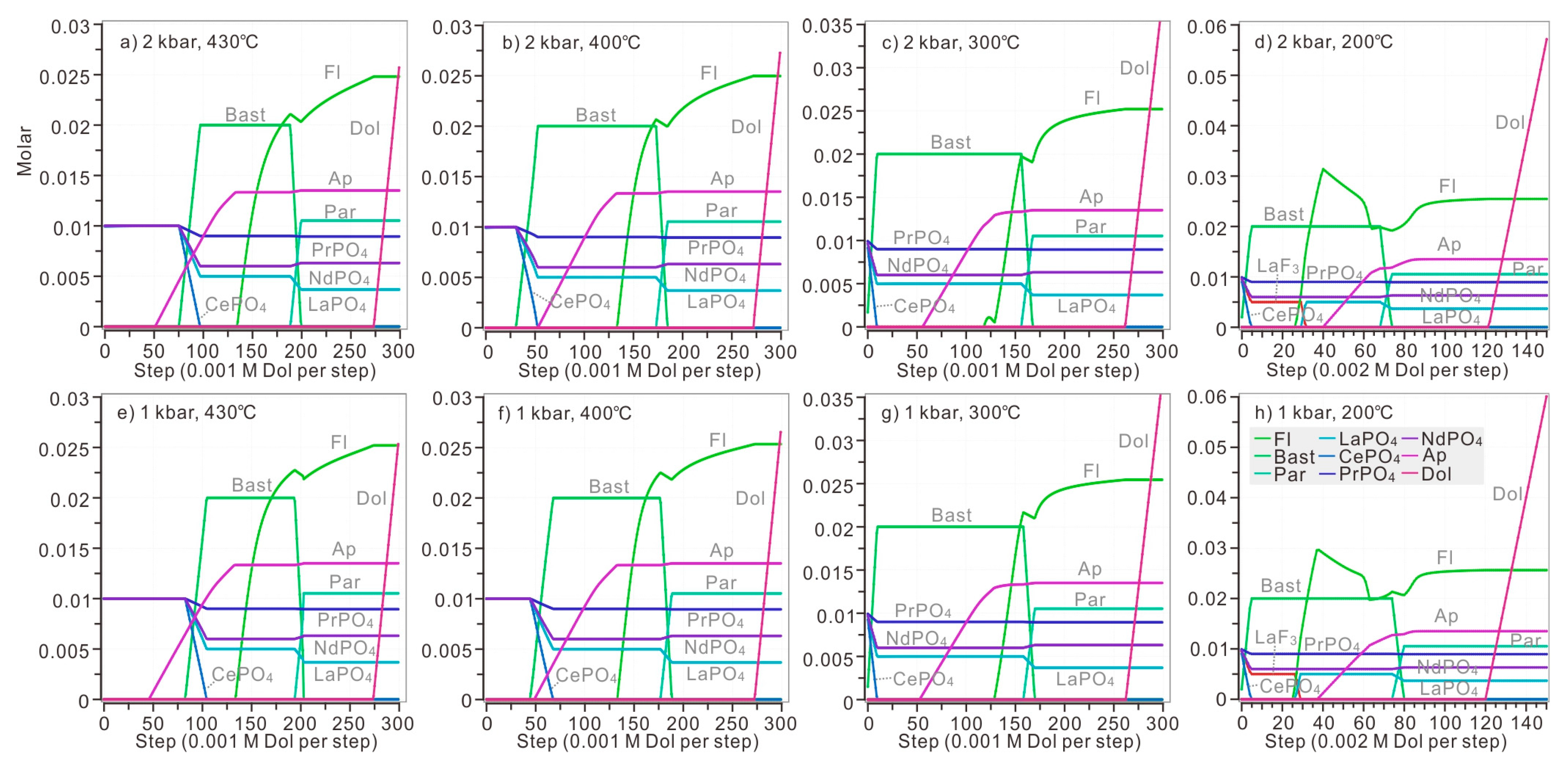


| Species | S0 (J/K·mol) | H0 (J/mol) | G0 (J/mol) | Cp0 (J/K·mol) | V0 (J/bar) | Cp0 = A0 + A1 × T + A2/T2 + A3/T10.5 + A4 × T2 | Reference | ||||
|---|---|---|---|---|---|---|---|---|---|---|---|
| A0 | A1 | A2 | A3 | A4 | |||||||
| LaF3 | 106.98 | −1,732,132 | −1,656,370 | 90.3 | 3.3000 | 255.870 | −0.16815 | −774,230 | −1972.4 | 8.4811 × 10−5 | [11,15,35] |
| CeF3 | 115.23 | −1,719,174 | −1,641,370 | 93.5 | 3.2010 | 103.258 | −0.01299 | −720,870 | 0 | 2.4688 × 10−5 | [11,15,35] |
| PrF3 | 121.22 | −1,717,746 | −1,641,370 | 92.7 | 3.1530 | 130.599 | −0.03250 | −2,655,590 | 0 | 1.8169 × 10−5 | [11,15,35] |
| NdF3 | 120.79 | −1,710,367 | −1,634,370 | 92.4 | 3.0930 | 103.387 | 0.00167 | −1,101,170 | 0 | 1.0394 × 10−5 | [11,15,35] |
| SmF3 | 116.50 | −1,701,074 | −1,624,370 | 91.7 | 3.1240 | 169.056 | −0.07681 | −4,840,760 | 0 | 0 | [11,15,35] |
| LaPO4 | 108.24 | −1,970,700 | −1,850,500 | 101.28 | 4.6013 | 121.128 | 0.03012 | −2,562,500 | 0 | 0 | [36,37,38,39,40,41] |
| CePO4 | 119.97 | −1,970,073 | −1,849,800 | 106.43 | 4.5073 | 125.209 | 0.02789 | −2,408,580 | 0 | 0 | [36,37,38,39,40,41] |
| PrPO4 | 123.24 | −1,969,500 | −1,850,500 | 106.0 | 4.4430 | 124.500 | 0.03037 | −2,449,500 | 0 | 0 | [36,37,38,39,40,41] |
| NdPO4 | 125.53 | −1,967,900 | −1,849,600 | 104.8 | 4.3842 | 132.963 | 0.02254 | −3,100,900 | 0 | 0 | [36,37,38,39,40,41] |
| SmPO4 | 122.49 | −1,965,700 | −1,846,900 | 105.6 | 4.2805 | 133.125 | 0.02347 | −3,068,790 | 0 | 0 | [36,37,38,39,40,41] |
| Bastnaesite-(Ce) | 150.90 | −1,808,400 | −1,709,700 | 111.4 | 4.2910 | 9259.000 | −9.07300 | 9,307,000 | 136,100 | 4.4600 × 10−3 | [12] |
| Parisite-(Ce) | 391.60 | −4,848,000 | −4,571,500 | 290.8 | 12.2710 | 2494.000 | −2.56400 | 5,943,000 | −28,420 | 1.4790 × 10−3 | [12] |
| apatite-(F) | 766.40 | −13,598,000 | −12,834,591 | 739.28 | 31.6652 | 1362.478 | 0 | −12,762,680 | −9243.46 | 1.4762 × 109 | [42,43,44,45] |
| Elements | Range | Banks et al. [47] | Bühn and Rankin [46] | Selected Value in This Study (mol/L) | ||
|---|---|---|---|---|---|---|
| Content in Fluid (ppm) | Molar in 1kg Solution | Content in Fluid (ppm) | Molar in 1kg Solution | |||
| La | max | 334.7 | 2.4 × 10−3 | 18,868 | 1.4 × 10−1 | 0.01 |
| min | 72.05 | 5.2 × 10−4 | 3361 | 2.4 × 10−2 | ||
| Ce | max | 582.6 | 4.2 × 10−3 | 12,797 | 9.1 × 10−2 | 0.01 |
| min | 83.97 | 6.0 × 10−4 | 3802 | 2.7 × 10−2 | ||
| Pr | max | 57.75 | 4.1 × 10−4 | 1223 | 8.7 × 10−3 | 0.01 |
| min | 6.27 | 4.4 × 10−5 | 353 | 2.5 × 10−3 | ||
| Nd | max | 190.5 | 1.3 × 10−3 | 3695 | 2.6 × 10−2 | 0.01 |
| min | 19.27 | 1.3 × 10−4 | 1055 | 7.3 × 10−3 | ||
| Sm | max | 33.76 | 2.2 × 10−4 | 568 | 3.8 × 10−3 | 0.01 |
| min | 3.43 | 2.3 × 10−5 | 162 | 1.1 × 10−3 | ||
| F | max | 5245 | 2.8 × 10−1 | 5000 | 2.6 × 10−2 | 0.1 |
| min | 358 | 1.9 × 10−2 | 12,000 | 6.3 × 10−1 | ||
© 2020 by the authors. Licensee MDPI, Basel, Switzerland. This article is an open access article distributed under the terms and conditions of the Creative Commons Attribution (CC BY) license (http://creativecommons.org/licenses/by/4.0/).
Share and Cite
Liu, S.; Ding, L.; Fan, H.-R. Thermodynamic Constraints on REE Mineral Paragenesis in the Bayan Obo REE-Nb-Fe Deposit, China. Minerals 2020, 10, 495. https://doi.org/10.3390/min10060495
Liu S, Ding L, Fan H-R. Thermodynamic Constraints on REE Mineral Paragenesis in the Bayan Obo REE-Nb-Fe Deposit, China. Minerals. 2020; 10(6):495. https://doi.org/10.3390/min10060495
Chicago/Turabian StyleLiu, Shang, Lin Ding, and Hong-Rui Fan. 2020. "Thermodynamic Constraints on REE Mineral Paragenesis in the Bayan Obo REE-Nb-Fe Deposit, China" Minerals 10, no. 6: 495. https://doi.org/10.3390/min10060495
APA StyleLiu, S., Ding, L., & Fan, H.-R. (2020). Thermodynamic Constraints on REE Mineral Paragenesis in the Bayan Obo REE-Nb-Fe Deposit, China. Minerals, 10(6), 495. https://doi.org/10.3390/min10060495






